![]()
![]()
![]()
Use LEFT and RIGHT arrow keys to navigate between flashcards;
Use UP and DOWN arrow keys to flip the card;
H to show hint;
A reads text to speech;
39 Cards in this Set
- Front
- Back
|
How do you acquire a hookworm infection?
|
By just coming into contact with the worm. You don’t have to swallow these worms. These are small worms, so we are not aware that we are being infected until it is too late.
|
|
|
What are the important species of hookworms?
|
Ancylostoma duodenale
Necator americanus |
|
|
What is the maximum a hookworm can crawl?
|
4 feet
|
|
|
Describe the construction of the outhouse and the results of its creation
|
They dug it 6 feet deep because the worms could only crawl 4 feet before dying. When polio, Shigella, E. coli, salmonella are sequestered 6 feet deep they can also no longer cause disease. Children no longer developed these infections and started going to school. This increased productivity.
|
|
|
How do countries that use human feces as fertilizer prevent hookworm infections?
|
They just ferment the feces for 6 weeks. This only prevents hookworm, not other diseases such as Shigella or Ascaris.
|
|
|
Describe the physical appearance of Ancylostoma duodenale
|
These are big worms that are visible to the naked eye
They have teeth allow the parasite to grab onto tissue and break off a piece and eat it. They have a big esophageal bulb that they also use to suck blood through. They derive the oxygen from the blood. |
|
|
Describe what occurs when hookworms suck blood.
|
Adult Ancylostoma duodenale have teeth allow the parasite to grab onto tissue and break off a piece and eat it. They have a big esophageal bulb that they also use to suck blood through. They derive the oxygen from the blood.
The adult Necator americanus suck less blood than Ancylostoma, 10x less. With enough worms you can have lots of blood loss. They also secrete anticoagulants at the site of the bite to keep the blood flowing. Once they finish eating the villus and move onto the next one the site keeps bleeding for about 3 days, leading to additional blood loss. |
|
|
Describe the role of the esophageal bulb
|
-It is for pumping the blood that the worm gets out of the single capillary in the submucosa.
-The blood goes in oxygenated and leaves the anus deoxygenated. It is not using digesting the blood at all, just using the oxygen. |
|
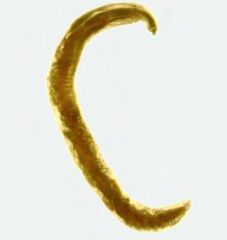
|
Adult female Ancylostoma duodenale
|
|
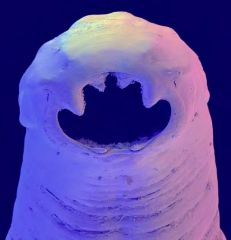
|
Adult Ancylostoma duodenale
These teeth allow the parasite to grab onto tissue and break off a piece and eat it. They have a big esophageal bulb that they also use to suck blood through. They derive the oxygen from the blood. |
|

|
Adult Necator americanus
These suck less blood than Ancylostoma, 10x less. |
|
|
Describe the life cycle of Necator americanus
|
-Larvae wait for host
-When host touches them they let go of their attachment -Crawl down hair follicle -Penetrate into blood -End up in lungs -Penetrate alveolar capillary -Crawl up epiglottus and are swallowed -Enter small intestine and bite -Become anergic while still taking blood -Adults continuously feed and mate -After mating the male passes out of the GI tract -Female makes eggs -Around 2 weeks later passes embryonated eggs out in stool -2-3 days later eggs hatch in soil and spread |
|
|
Describe the pathogenesis of the adult hookworm
|
Sucks flood and feeds of villus tissue. The anti-coagulant that this worm has involved inhibits coagulation cascade in two different places. The medical leech only does it in one place.
|
|
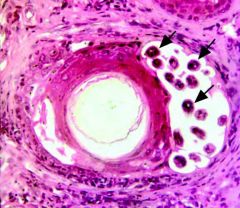
|
Hookworm larvae in dog skin penetrating into blood supply
|
|
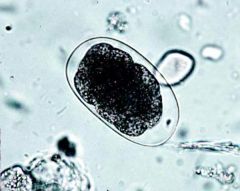
|
Hookworm egg
|
|
|
How do you diagnose hookworms?
|
Microscopic examination of feces for eggs
|
|
|
What is the drug of choice for treating hookworms? How does it act?
|
Mebendazole
It depolymerizes invertebrate microtubules only |
|
|
How do you prevent and control hookworms?
|
Outhouses
|
|
|
Describe the distribution of number of hookworms in people
|
There are very few people harboring lots of worms and a lot of people harboring very few worms. The people with lots of worms are thought to be genetically different with regards to their ability to fight off these infections.
|
|
|
What is Ancylostoma caninum?
|
Dog hookworm
|
|
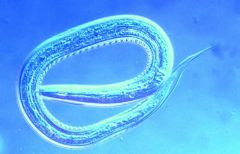
|
Ancylostoma caninum infectious larva
|
|
|
What happens when non-human hookworms come into contact with human skin?
|
They penetrate the skin. At which point they begin to sense us with chemoreceptors. A dog parasite that penetrates the dog's skin will continue the lifecycle and end up in the small intestine. In people this parasite instantly realizes it is in the wrong host, so it crawls around trying to escape. It has about 6 weeks of life and then it dies. Along the way it secretes lytic enzymes, mostly metalloproteases. As a result of that wandering they illicit allergic reactions that eventually come to the clinic.
It causes cutaneous larva migrans |
|
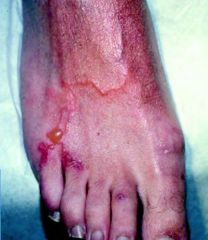
|
Cutaneous larva migrans or "Creeping eruption"
|
|
|
How do you treat creeping eruption/cutaneous larva migrans?
|
You take a gauze pad and you soak it in thiabendazole. Thiabendazole has some anti-inflammatory properties n its on. In addition it will soak through the skin and kills the worm. You will then stop the worm from migrating any further. In a couple days these lesions will resolve.
|
|
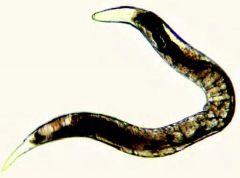
|
Free-living female Strongyloides stercoralis
|
|
|
Where does Strongyloides stercoralis live?
|
It can be free-living in soil or a human parasite
|
|
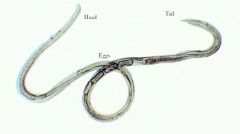
|
Parasitic female Strongyloides stercoralis
|
|
|
Describe the life cycle of Strongyloides stercoralis
|
-Larvae penetrates unbroken skin
-Crawls down hair follicle shaft and enters blood stream -Larva reaches lung capillaries -Enters alveolar spaces -Crawl up esophagus and are swallowed -In the small intestine, develops into a male -It makes male organs, builds sperms, then destroys the male organs, keeps the sperm, rebuilds itself as a female and self-fertilizes. -The female begins to lay eggs. The eggs hatch in the tissues and the larvae develop in the tissues until they reach the second stage of their lifestyle. The second stage passes out with feces into the environment. -They undergo another molt and become third stage worms and they can then infect another host -ALTERNATIVELY, If there is a bowel obstruction or the passage of feces is slowed then these worms have the options of advancing to the third stage within the host. It is the third stage that is infectious. If you produce a third stage worm in your large intestine the worm can then penetrate the unbroken intestinal wall, get into the blood supply, and undergo the ascaris life cycle, enter the small intestine and establish another adult worm. |
|
|
How does Strongyloides stercoralis cause sepsis?
|
-Second stage of this worm eats bacteria
-They get the bacteria from your fecal pellet. They will eat whatever the fecal mass is made out of. -When it becomes a third stage larva, it regurgitates whatever is left in its gut tract and doesn’t feed anymore until it completes its life cycle, ending up in the small intestine. -A second stage worm in the blood about to become a third stage is going to release all those stored up bacteria that it has ingested and deposit those bacteria in the tissue. -These worms can migrate everywhere so they can release bacteria everywhere. In these cases, where there is a third stage worm in the stool, you give massive amounts of IV antibiotics. You begin to treat the infection as well. In many cases this is detected too late and the patient can die from the septicemia. This used to be a big deal in kidney transplants, especially when patients became immunocompromised. |
|
|
Where in the small intestine does Strongyloides stercoralis live?
|
It lived embedded in a row of columnar cells in the small intestine. The adult and the larva live inside the matrix of the columnar cells in the small intestine. It doesn’t create a syncytium. Instead it just kills the cells because you make so many of them. This disease looks like Crohn's disease.
|
|
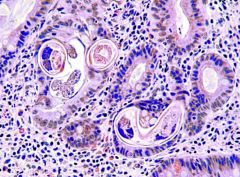
|
Strongyloides stercoralis in situ
|
|
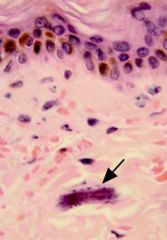
|
Larva of Stronguloides stercoralis in skin
|
|
|
Describe the pathogenesis of Strongyloides stercoralis
|
Worms invade epithelial cells, induce cell death
That cell death, if there are enough worms present, can induce a diarrheal disease. |
|
|
What are the clinical manifestations of Strongyloides stercoralis infection?
|
1. Diarrhea
2. Malabsorption syndrome 3. Secondary bacteremia/septicemia as larvae migrate throughout body and defecate microbes that they ingested in the large intestine 4. Death due to overwhelming bacterial septicemia Heavy infection results in diarrhea. Malabsorption follows that. You die from an overwhelming septicemia from a bacteremia from the migrating larvae that never left your body and can now infect you. |
|
|
How do you diagnose Strongyloides stercoralis infection?
|
1. Microscopic examination of feces (x6)
2. String test The diagnosis is made by looking for the larvae. For people receiving an organ, do multiple stool samples to ensure that they do not harbor this worm to begin with. You have to do it for at least 6 times because during the early stages of this infection there are very few larvae being produced so the likelihood of finding anything is low. You can also do a string test, which involves passing a string into the small intestine, letting it sit there overnight, removing it and examining it microscopically. |
|
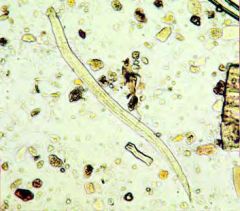
|
Second stage larva of Strongyloides stercoralis
|
|
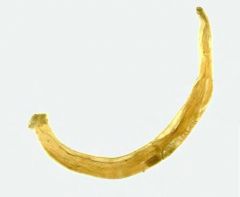
|
Adult male Ancylostoma duodenale
|
|
|
What is the drug of choice for Strongyloides stercoralis infection? What is its mode of action?
|
Ivermectin
It blocks Cl- ion channels, inhibits the GABA receptor complex It is also an alternate drug for all geohelminths |
|
|
How do you prevent and control Strongyloides stercoralis infection?
|
By having sanitary disposal of human feces
The dog is a common reservoir host. Cannot control spread of dog feces which may contain infective larvae |

